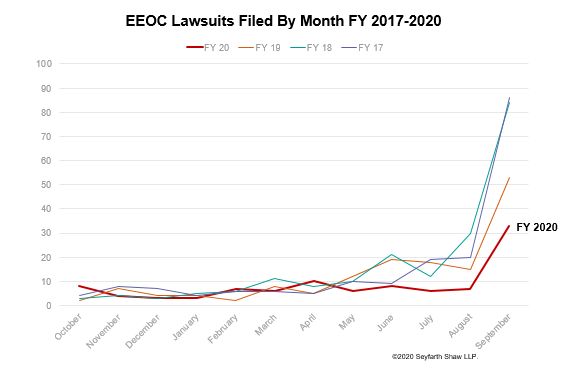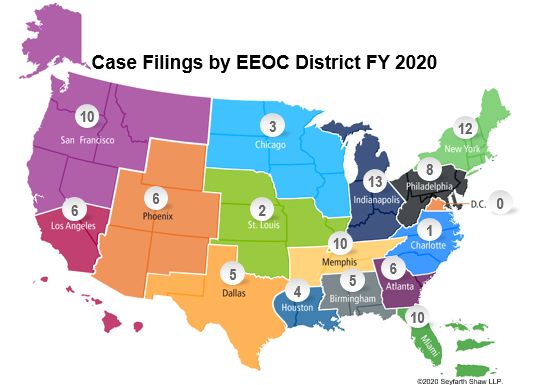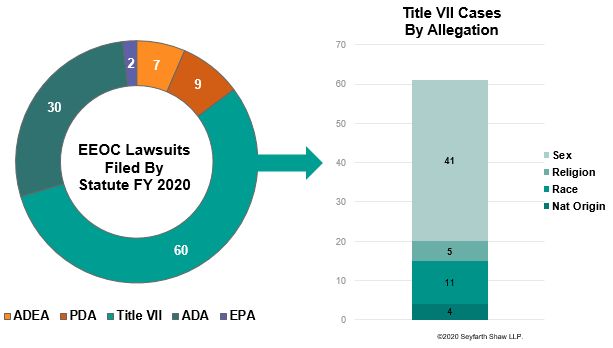Seyfarth Synopsis: In the last fiscal year before the November 2020 election, the EEOC made significant changes to many of its programs, all in the midst of the global COVID-19 pandemic. Like most employers across the country, the EEOC found itself reconsidering its priorities and resources to address the pandemic, issuing a series of guidelines to assist employers with navigating the challenges of COVID-19. To top it off, the EEOC experienced significant leadership changes in the last few days of the Fiscal Year, with three new Commissioners approved by the U.S. Senate within the last week. The immediate impact of this flurry of activity appears to be a substantial drop in cases filed by the EEOC.
When the EEOC's last fiscal year before the November election began in October 2019, many expected that the agency would be busy completing many of its objectives to further the strategic priorities set by the new Chair of the Commission, Janet Dhillon. However, FY 2020 was thrown in an unexpected direction by the COVID-19 pandemic, causing an unanticipated interruption in the EEOC's enforcement and litigation program.

For the better part of the last 25 years, the EEOC's Fiscal Year ended with a predictable spike in last-minute lawsuits; August and September filings often eclipsed the entire rest of the year combined. Not so this year. FY 2020 ended with a whimper, with only 33 lawsuits filed during September (unlike the 52 filed in September of FY 2019 and the 84 in FY 2018). In the end, the agency's total number of filings fell dramatically below the numbers posted the last several years. At the time of publication of this blog posting, the EEOC had filed 101 total cases in FY 2020, which includes 94 merits lawsuits and 7 subpoena enforcement actions. This total number of filings is significantly less than the last two years (see here and here), and is closer to the drop off in filings that we saw in FY 2016 (see here).
Cases Filed By EEOC District Offices
In addition to tracking the total number of filings, we also keep a close watch on which of the EEOC's 15 district offices are most actively filing new cases. Some districts tend to be more active than others, and some focus on different case filing priorities. The following chart shows the number of lawsuit filings by EEOC district office.

The most noticeable trend of FY 2020 is the marked decrease in coast-to-coast filings that we have seen compared to past years. Leading the pack in new filings were the Indianapolis and New York district offices, with 13 and 12 filings respectively. Indianapolis's filings shot up from 8 filings last year, and New York matched its 12 filings from FY 2019. The Charlotte office, which was one of the leaders in new filings last year, posted extremely low numbers in FY 2020. The Chicago district office has historically been at the head of the pack, but had only 3 new filings this year, and the Houston office was down to 4 filings from the 12 it posted last year. This marks one of the most substantial declines in litigation enforcement activity that we have seen on a year-over-year basis.
Analysis Of The Types Of Lawsuits Filed In FY 2020
Each fiscal year we also analyze the types of lawsuits the EEOC files, in terms of the statutes and theories of discrimination alleged, in order to determine how the EEOC is shifting its strategic priorities. Those numbers at least - when considered on a percentage basis - are in line with the numbers we have seen the last few years, possibly indicating less of a shift in priorities than expected from the agency's new leadership under Chair Dhillon. The graphs below show the number of lawsuits filed according to the statute under which they were filed (Title VII, Americans With Disabilities Act, Pregnancy Discrimination Act, Equal Pay Act, and Age Discrimination in Employment Act) and, for Title VII cases, the theory of discrimination alleged.

Although the total number of filings is down across the board, when considered on a percentage basis, the distribution of cases filed by statute remained roughly consistent compared to FY 2018 and 2019. Title VII cases once again made up the majority of cases filed, making up 60% of all filings (on par with the 60% in FY 2019 and 55% in FY 2018). ADA cases also made up a significant percentage of the EEOC's filings, totaling 30% this year, though down from 37% in FY 2019. This too is fairly typical. There were only 7 age discrimination cases filed in FY 2020, the same number as FY 2019.
COVID-19 Guidance
On March 17, 2020, near the beginning of the coronavirus pandemic in the United States, the EEOC released a technical assistance guide: What You Should Know About the ADA, the Rehabilitation Act, and COVID-19, which aimed to provide employers some guidance on how to navigate the safety concerns associated with COVID-19 while staying in compliance with the federal disability and other discrimination laws. The EEOC periodically updated the guide throughout the course of the pandemic to address employers' questions, including those related to reasonable accommodations, COVID-19 screening and testing, and furloughs and layoffs. The EEOC also held a webinar on March 27, 2020, to answer common questions from employers relative to the application of discrimination laws to issues posed by the pandemic.
On March 21, 2020, the EEOC announced that it would cease issuing charge closure documents, also known as Notices of Right to Sue ("Notices"), in response to the difficulties facing parties in light of the COVID-19 pandemic. The closure documents were suspended until August 3, 2020.
Significant Changes To The EEOC's Policies And Procedures
Throughout FY 2020, the EEOC undertook significant efforts to amend or limit its enforcement policies and procedures in accordance with its strategic priorities announced by Chair Dhillon earlier this year. Such priorities included continuing to provide excellent customer service; continuing to provide robust compliance assistance to employers, enhancing efforts to reach vulnerable workers; strategically allocating Commission resources; and continuing the EEOC's efforts to be a model workplace. These priorities emphasized goals of consistency and an acknowledgement that litigation is "truly a last resort."
On July 7, 2020, the EEOC announced two new six-month pilot programs aimed at increasing voluntary resolutions of discrimination charges. One of the new programs seeks to increase the effectiveness of the conciliation process at the Commission by reestablishing the commitment for full communication between the EEOC and the parties to a charge of discrimination and, notably, adding a requirement that conciliation offers be approved by an "appropriate level of management" before they are shared with respondents. The other program looks to create more opportunities to resolve matters through the EEOC's popular mediation process by expanding the kinds of charges eligible for the mediation process and allowing for mediation throughout the entire charge investigation.
On August 18, 2020, the EEOC held a public meeting to address a notice of proposed rulemaking containing potential substantive amendments to the Commission's conciliation process. Though a copy of the notice has not yet been publicly released, the EEOC has stated that the proposed changes to the conciliation process aim to "enhance its effectiveness and to create accountability and transparency." Those changes could require the EEOC to disclose more substantial portions of its investigation file to respondents - including the identities of individuals who participated in the investigation, a summary of the known facts, and the factual and legal analyses that support a for-cause finding by the Commission.
Finally, on September 3, 2020, the EEOC issued an opinion letter regarding the Commission's interpretation and enforcement of § 707(a) of Title VII, which authorizes the EEOC to sue employers engaged in a "pattern or practice" of discrimination. The opinion letter states that: (1) a pattern or practice claim under section 707(a) requires allegations of violations of section 703 or section 704 of Title VII; and (2) the EEOC must satisfy pre-suit requirements such as conciliation before it can bring a section 707 case. Although technical, these points put significant limitations on the EEOC's enforcement powers as to pattern or practice cases (a full summary of the opinion letter is covered in an earlier blog post here).
More Changes At The Top
On top of all this, the EEOC is facing more leadership turnover at the top. Prior to last week, the EEOC's leadership included only three of five Commissioners: Janet Dhillon (Republican – Chair), Vicki Lipnic (Republican), and Charlotte Burrows (Democrat). Commissioner Lipnic's term technically expired in July 2020, but she has been allowed to stay on so the Commission still had a quorum and could still operate.
On September 22 and 23, 2020, three new Commissioners, two Republicans and one Democrat, were confirmed by the Senate for the two vacant seats and the seat held by Commissioner Lipnic. The Commission must remain bipartisan by law, but these new additions effectively solidify a Republican majority at least until July 2022 when Chair Dhillon's term expires, regardless of the outcome of the upcoming elections.
The two new Republican Commissioners are Andrea Lucas, currently an attorney at the law firm Gibson Dunn who represents employers in labor and employment disputes, and Keith Sonderling, currently the Deputy Administrator of the Department of Labor's Wage and Hour Division. Both are expected to add conservative voices at the Commission. The new Democratic Commissioner, Jocelyn Samuels, is currently the Executive Director of the Williams Institute and has served as the Director of the Office for Civil Rights at the U.S. Department of Health & Human Services. She is a strong advocate with a focus on LGBTQ+ issues.
On September 30, 2020, Sonderling was sworn in as Commissioner.
Implications For Employers
FY 2020 has shaped up to be a year of whirlwind change at the EEOC. The EEOC is starting to reflect the changes in priorities and leadership that many expected out of the Trump Administration, but that, until now, had been slow in coming. Now that they are finally here, they have landed in a world that has been turned upside down by a global pandemic. Employers find themselves once again looking out over a dim and uncertain horizon, as it remains to be seen how new priorities and strategies will be applied to a radically different employment landscape.
We will continue to monitor these changes closely and keep readers apprised of developments. Our annual comprehensive analysis of trends in EEOC litigation will be published at the end of the calendar year. As always, we will keep abreast of EEOC data amid the ever-changing political milieu, and share lessons learned from FY 2020 to carry employers through the new year.
Readers can also find this post on our EEOC Countdown blog here.
The content of this article is intended to provide a general guide to the subject matter. Specialist advice should be sought about your specific circumstances.




